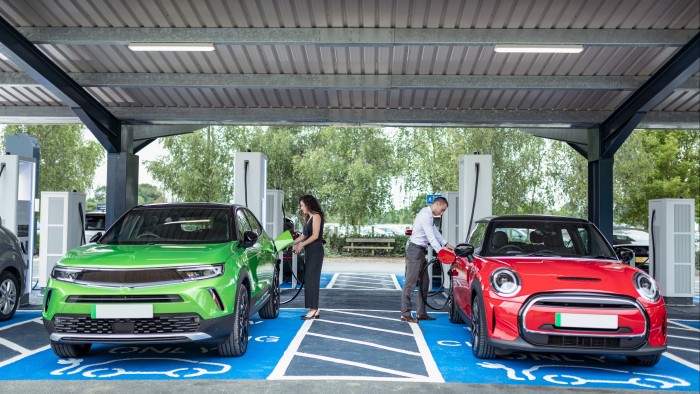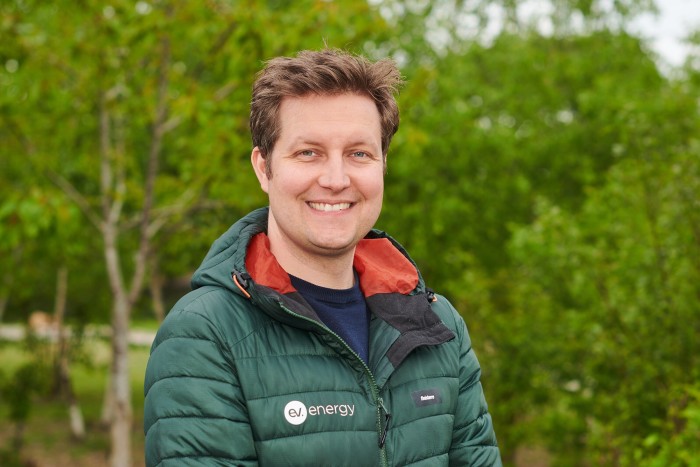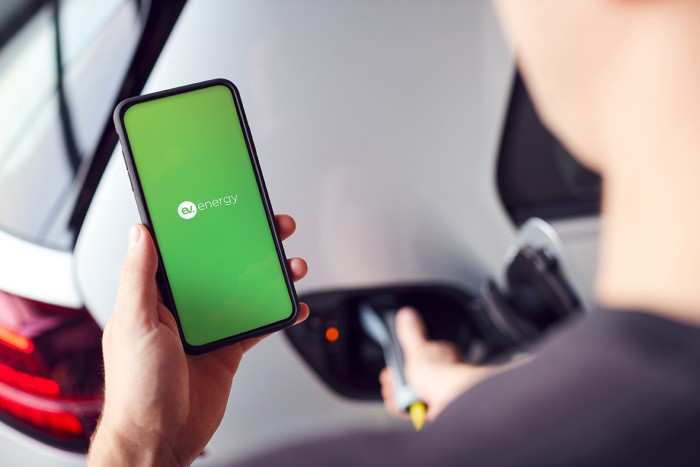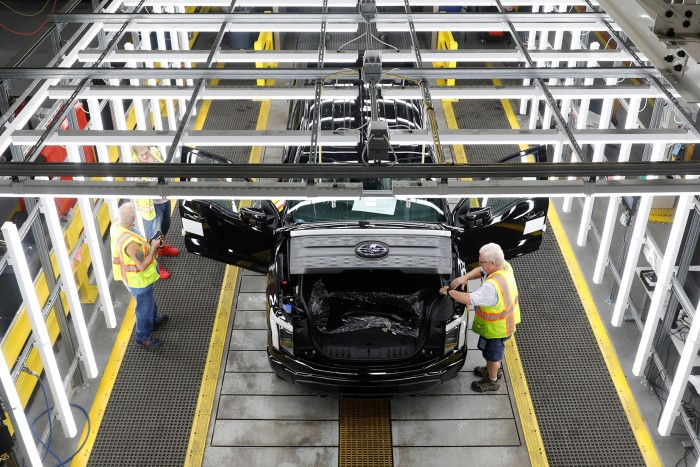Ev.energy wants to be the ‘Android’ of electric car charging

Simply sign up to the Electric vehicles myFT Digest -- delivered directly to your inbox.
Europe’s need to wean itself off Russian gas, as supplies are cut amid the war in Ukraine, leaves the continent facing an energy shortfall — just as winter approaches. Short-term power cuts, a return to nuclear generation, and more gas stockpiling have all been proposed to fill the gap, but remain problematic. One answer may already be out there, though, sitting on our driveways: electric cars.
In the UK alone, more than 1mn electric vehicles have been sold in the past decade. And they contain batteries that together hold as much electricity as several power stations could produce. Harnessing this vast reservoir, to power homes and help “balance the grid”, may prove the key to keeping the lights on in the months ahead.
Ev.energy certainly thinks so — and, as an energy technology company, it aims to do exactly that. It has written software for electric car chargers that “talks” to vehicles and the grid at the same time. At present, it allows vehicles to recharge during hours of low demand, but it will eventually let them feed their electricity back into the energy system.
“Electric vehicles will be the single biggest source of energy flexibility in the future,” says Nick Woolley, Ev.energy chief executive. Combining the cars together under one system creates a “virtual power plant, and that becomes very important to the grid”, he explains. “If you control that power plant, you control the grid.”
By 2050, the UK will consume at least twice the amount of electricity it does today, according to National Grid calculations. That will require at least four times the amount of clean generation it currently achieves, and twice the grid capacity. To cope, the grid will have to become smarter and demand will have to be managed. Electric cars, which are expected to be near-ubiquitous within two decades in certain parts of the world, allow a huge buffer in doing this.
“People are worried about EVs and their charging impact on the grid but, in reality, they are part of the solution,” argues Fiona Howarth, chief executive of Octopus EV, an electric car leasing business owned by the Octopus energy group.

Woolley first grasped the size of the electricity demand challenge when he was working in National Grid’s strategy team. “The [power] networks are worried because it is going to overload the local network; the National Grid is worried because they will have a massive peak demand; and energy companies are worried because they will have to pay very high prices for their energy,” he says. But when he also factored in demand from millions of electric vehicles, he spotted a power-station-sized gap in the market.
Ev.energy is not his first foray into running a business. Though an engineer by training, he initially switched between roles at Boston Consulting Group and shepherding his own ventures. He ran his first enterprise — a small outfit that helped people trade online — from his bedroom while studying for a PhD in power systems.
His first serious business was called Kudos Web Solutions, which developed software to help companies launch their own websites. Its highest-profile client was online fashion retailer Boohoo. But Woolley later sold his share of the company to his business partner and went back to considering opportunities in power.
“The energy sector is about the most exciting place to build a business today, because we fundamentally have an enormous problem in climate change and I’m very optimistic we can use technology in the right way to help solve that,” he says.
Ev.energy has so far raised $12.8mn from investors, including Energy Impact Partners and Canada’s Arctern Ventures. It has also struck deals with more than 20 energy and utility groups — among them Eon — as well as several network operators, including UK Power Networks and Southern Company in the US.
Earlier, Ev.energy was supported by German carmaker Volkswagen’s incubator programme and it is now a commercial customer. In addition, it received project funding from Innovate UK, which aids promising young businesses. “For what is still an early-stage business, they have gone international quite early,” says one early investor in the company.
While a lot of businesses “talk about that big global ambition”, most “don’t really know how to get there, and end up concentrating on the UK, and ultimately they almost always meet a roadblock”, the person adds.
“Being involved in the Texas market and in California, they really are picking the early adopters to prove the value in these markets,” says another early backer.
Ev.energy has 100,000 vehicles registered on its charging network, and aims to increase this to 1mn within three years — a figure that, Woolley says, could rise as high as 3mn if registrations grow fast enough. It has revenues in the millions and is currently focused on growth rather than turning a profit.

Achieving growth should not require vast resources or financing, however, as the company does not need to spend on infrastructure or physical hardware. An increase in electric vehicles on the roads ought to see its network expand with the market. “We don’t need huge amounts of cash,” Woolley says. “We just need great engineers. Fundamentally, we need to get scale of EVs and that will make our platform valuable.”
Through his connections at National Grid, Woolley was able to draw on expert advice when honing the product. Graeme Cooper, an electric vehicle advocate who heads National Grid’s future markets division, was one of the company’s guinea pigs back in 2017. An early adopter of electric vehicles, he was nevertheless pleasantly surprised when he plugged in his Tesla and found the system allowed him to set when he needed the vehicle charged by, and how full the battery needed to be. Everything else was determined by the app itself.
“I put in the energy tariff, it found the signal and it made some judgments [about when to charge]. These guys have done some clever stuff,” Cooper concludes. Five years later, he still uses the system to charge his current vehicle, an electric Mercedes-Benz. His most frequent use of the app is to reset his password, which he barely uses because the technology “just works well”.
Ev.energy estimates that delaying charging until later at night can save consumers up to £800 a year, especially when combined with solar panels that take power straight to the car. Come this winter, it should also help ease the load on the grid, which can pay Ev.energy to delay taking power during periods of high demand.
Woolley cites examples from California, which has been subject to rolling power cuts when high temperatures lead to unsustainable demand for air conditioning. Flexible EV charging can reduce demand on the grid by 96 per cent “just by listening to their requirements and the grid requirements and meeting the two together” he says.
In time, feeding power back into the grid will increase this effect, not only reducing demand on the grid but in effect acting as a “virtual” power station.
But developments such as these bring their own risks to Ev.energy’s business model. Hardware providers could start to run their own software systems, for example. Or the business may become so large that the energy companies currently bankrolling it see it as a competitive threat.
Some car manufacturers are already tapping the potential of vehicle-to-grid technology. Ford’s F-150 Lightning, the electric version of its flagship pick-up, contains two-way charging that allows motorists to draw power from its battery. Advertising for the vehicle shows builders using this facility to power construction tools on site. But others are more imaginative: online videos feature people using the Ford technology to charge Teslas, a plug-in Ferrari supercar, and even a rural wedding after a local power cut.

Largely, however, carmakers have shied away from offering charging software itself. Even Tesla, whose Supercharger network is the only significant in-house offering on the market, does not provide it. In fact, most of the cars that sit on Ev.energy’s smart-charging system today are Teslas.
Woolley claims the chances of carmakers trying to compete in smart charging are slim. He even says that Ev.energy’s global reach can prevent direct competition from hardware makers as well.
“The challenge is that energy is completely different in the UK, Germany, France, Luxembourg, Texas . . . it’s just completely fragmented everywhere, different rules and regulations. If you’re that charging company, you have to figure out how to sell your global product because you probably want to sell your devices everywhere,” he says.
Woolley likens the role, and the potential, of Ev.energy’s technology to that of Google’s Android operating system for mobile phones. He believes it can benefit from a range of hardware providers — in this case, charging groups. But he adds: “The question is, who becomes Apple?”
Climate Capital

Where climate change meets business, markets and politics. Explore the FT’s coverage here.
Are you curious about the FT’s environmental sustainability commitments? Find out more about our science-based targets here
Comments